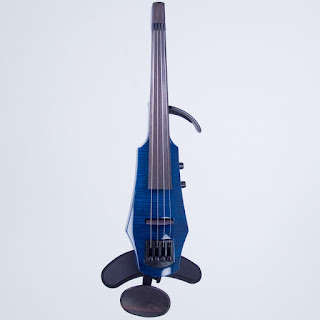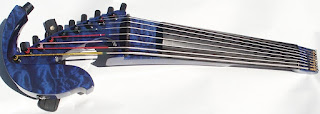Music Guide: How to Choose an Electric Violin (in 2023)
1. Define Your Purpose
Before plunging into the vast world of electric violins, it's crucial to identify your purpose. Are you a classical musician seeking to experiment with different sounds, a rock enthusiast looking to electrify your performances, or a student searching for a practice instrument? Knowing your purpose will help you narrow down your options and find an electric violin that resonates with your musical aspirations.
Example: If you're a classically trained violinist looking to explore electronic genres, the Yamaha SV-250 Silent Violin offers a seamless transition with its ergonomic design and impressive sound capabilities.

2. Consider Your Budget
Electric violins come in a wide price range, so it's essential to set a budget that aligns with your financial capacity. High-end electric violins may offer more advanced features and superior sound quality, but there are also budget-friendly options that provide a good starting point for beginners or those with limited funds.
Example: The NS Design WAV4 Electric Violin is a great option for budget-conscious musicians, offering excellent build quality and decent sound at a fraction of the cost of some premium models.
3. Decide on the Number of Strings
When choosing an electric violin, you'll need to decide between a traditional 4-string configuration or a 4+ string setup. The number of strings you choose can significantly impact the range and versatility of your instrument.
On the other hand, a 4+ string electric violin such as the Jordan violins expands the sonic possibilities by adding extra strings. These additional strings may include a low C string, low F string, and even a low Bb string for 7-string violins. The extra strings can extend the range of the instrument, allowing for more complex harmonies, extended lower or higher notes, or the inclusion of sympathetic resonance.
4. Assess Build Quality and Design
The build quality of an electric violin directly impacts its playability and durability. Look for instruments made from sturdy materials that can withstand the demands of regular use. Additionally, consider the design and ergonomics of the violin, as comfort during long performances or practice sessions is vital.
Example: The Wood Violins Stingray SVX4 is a stellar example of an electric violin with exceptional build quality and a sleek, modern design that ensures a comfortable playing experience.
5. Evaluate Sound Quality
Sound quality is arguably the most critical factor when choosing an electric violin. While traditional violins produce acoustic sound, electric violins rely on pickups and preamps to capture and amplify the sound. Listen to demos or try out the instruments in person to assess their tonal characteristics, dynamic range, and responsiveness.
Example: The ZETA Strados Electric Violin is renowned for its exceptional sound quality, providing rich, expressive tones that cater to a wide range of musical genres.

6. Explore Connectivity Options
The beauty of electric violins lies in their versatility, allowing you to experiment with various effects and connect to amplifiers, audio interfaces, or effects pedals. Ensure that the electric violin you choose has the necessary output options to suit your performance or recording needs.
Example: The Yamaha YEV104NT Electric Violin is equipped with dual output selector, giving you the flexibility to blend both the acoustic and electric sounds, perfect for studio recording or live performances.

7. Prioritizing Physical Ergonomics
Playing the violin requires proper posture and positioning, which can sometimes lead to discomfort or strain, especially during extended practice or performance sessions. Physical ergonomics in electric violins can play a crucial role in alleviating these issues and providing a more comfortable playing experience.
Example: The Mark Wood Viper Violin is renowned for its revolutionary strap system, designed to distribute the weight of the instrument across the shoulders and back. This innovative design not only enhances comfort but also offers potential relief for violinists who suffer from certain types of back pain issues. The adjustable straps allow for personalized fit and support, making it an excellent choice for those seeking a more ergonomic playing experience.
By prioritizing physical ergonomics, you can ensure that your electric violin adapts to your body and playing style, reducing strain and enhancing overall comfort. This is particularly beneficial for musicians who spend significant amounts of time practicing or performing, as it can help prevent long-term injuries and discomfort.
8. Fretted or Non-Fretted: Considerations for Loud Shows
When performing in loud and energetic shows, whether in a band or solo setting, the choice between a fretted or non-fretted electric violin can have a significant impact on your performance and stage presence.
Fretted electric violins feature metal or synthetic frets embedded along the fingerboard. These frets divide the fingerboard into specific intervals, making it easier to produce accurate intonation and play in tune, especially in high-energy performances where precise finger placement might be more challenging.
On the other hand, non-fretted electric violins offer a more traditional playing experience similar to acoustic violins, without the frets. Playing a non-fretted electric violin requires a well-developed sense of pitch and intonation. This can be advantageous for musicians who have mastered the technique and prefer the freedom of expression that comes with playing on an unfretted fingerboard.
When performing in loud and energetic shows, whether in a band or solo setting, the choice between a fretted or non-fretted electric violin can have a significant impact on your performance and stage presence.
Fretted electric violins feature metal or synthetic frets embedded along the fingerboard. These frets divide the fingerboard into specific intervals, making it easier to produce accurate intonation and play in tune, especially in high-energy performances where precise finger placement might be more challenging.
On the other hand, non-fretted electric violins offer a more traditional playing experience similar to acoustic violins, without the frets. Playing a non-fretted electric violin requires a well-developed sense of pitch and intonation. This can be advantageous for musicians who have mastered the technique and prefer the freedom of expression that comes with playing on an unfretted fingerboard.
Conclusion
Choosing the right electric violin is an exciting journey that opens up a universe of musical possibilities. By defining your purpose, considering your budget, assessing build quality, evaluating sound capabilities, and exploring connectivity options, you can find an instrument that resonates with your unique musical style and aspirations.
Remember that each violinist's journey is distinct, and what works for one may not work for another. Trust your instincts and let the music guide you towards the electric violin that harmonizes with your soul. Whether you're mesmerizing audiences with classical melodies or rocking the stage with electrifying beats, your chosen electric violin will be your trusted companion in creating extraordinary music. Happy playing!
Choosing the right electric violin is an exciting journey that opens up a universe of musical possibilities. By defining your purpose, considering your budget, assessing build quality, evaluating sound capabilities, and exploring connectivity options, you can find an instrument that resonates with your unique musical style and aspirations.
Remember that each violinist's journey is distinct, and what works for one may not work for another. Trust your instincts and let the music guide you towards the electric violin that harmonizes with your soul. Whether you're mesmerizing audiences with classical melodies or rocking the stage with electrifying beats, your chosen electric violin will be your trusted companion in creating extraordinary music. Happy playing!









Comments
Post a Comment